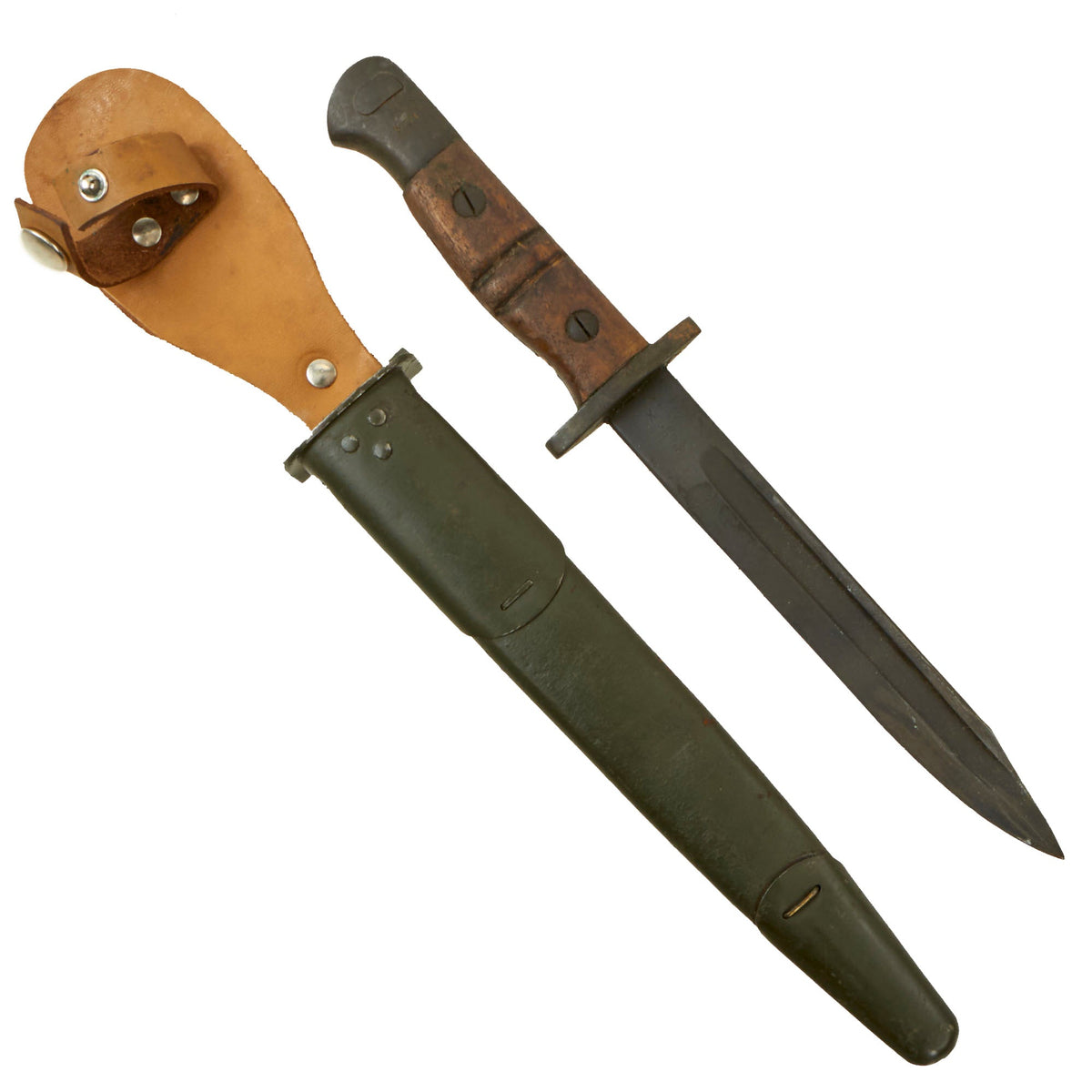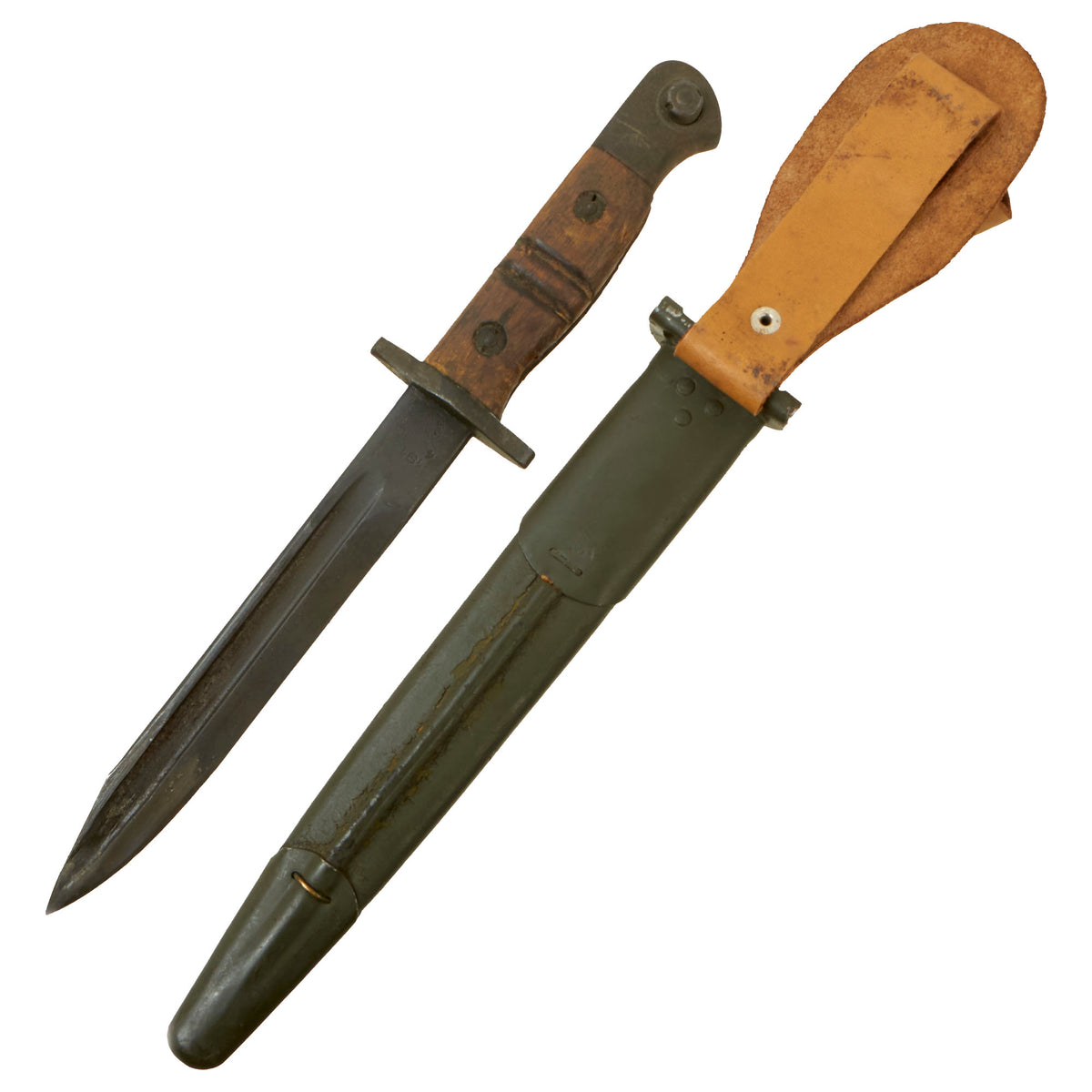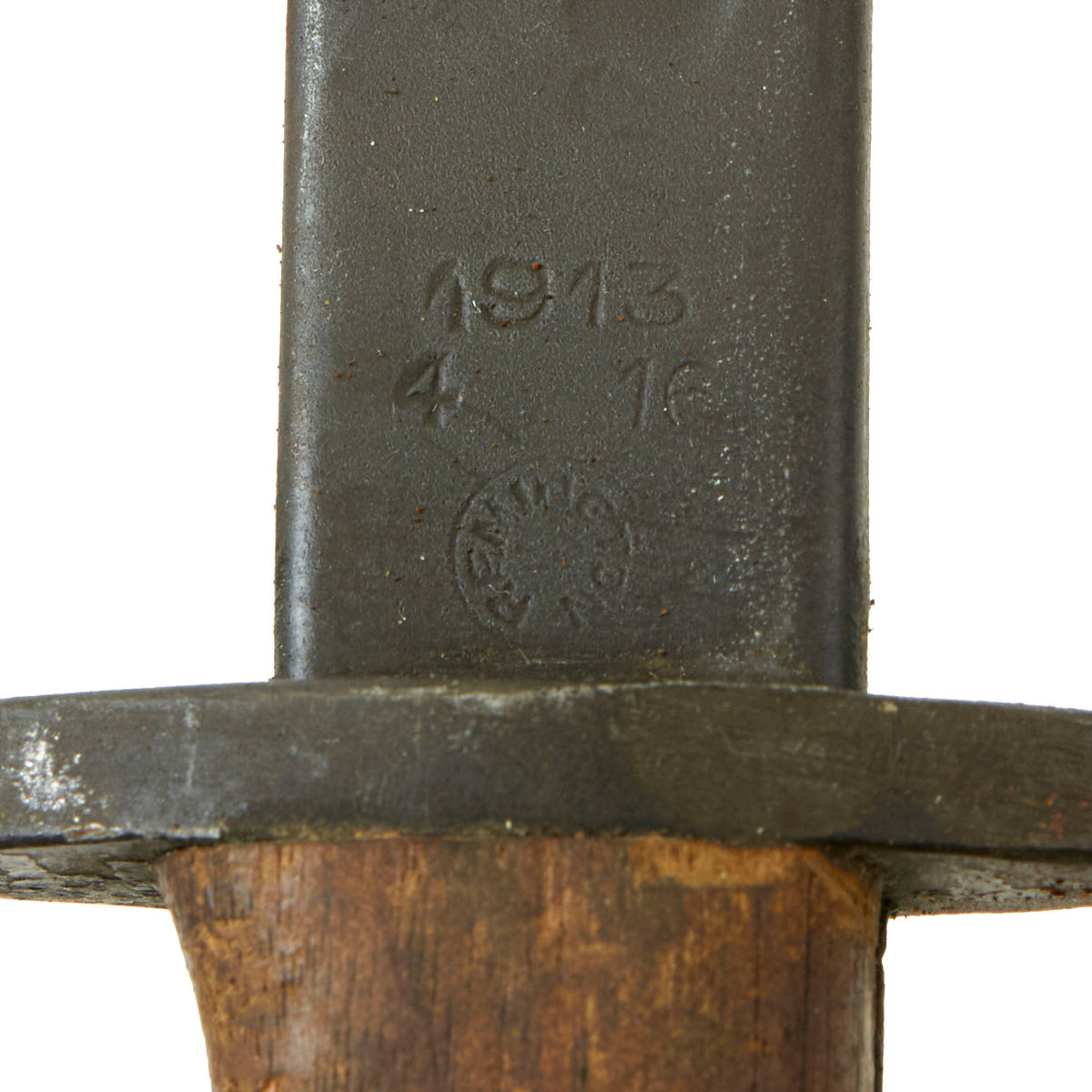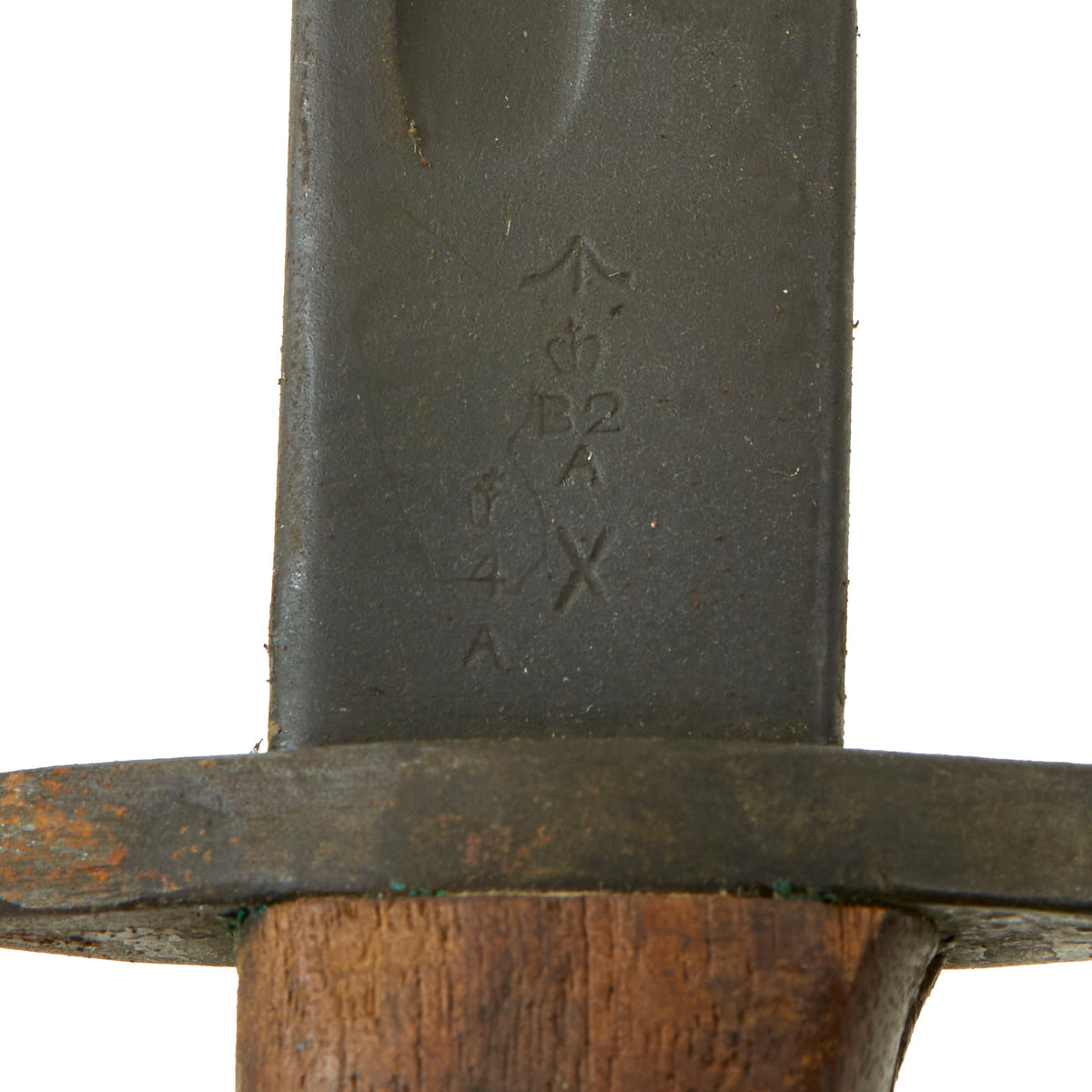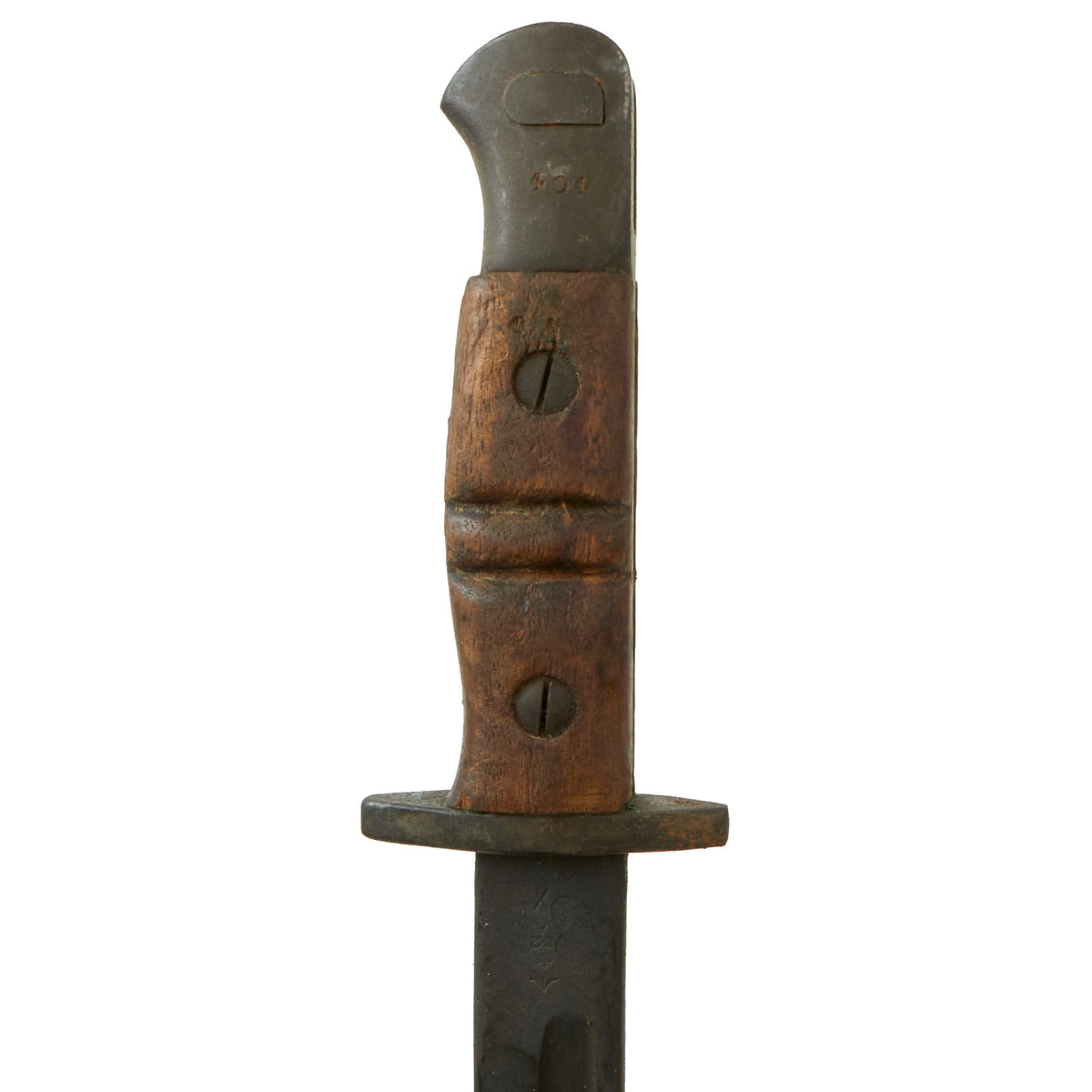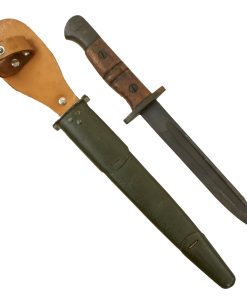Original British WWI P1913 Enfield Bayonet by Remington with Scabbard Cutdown For French-Indochina War Era French Army Use – Dated 1916 Original Items
$ 395,00 $ 118,50
Original Item: Only One Available. This is a very nice cutdown British WWI P-1913 bayonet, made by REMINGTON Arms Company in the U.S. for the British Army’s Pattern 1914 Enfield (P-14) Rifle.
The blade ricasso is marked 1913 / 4 16 on the blade ricasso over the round REMINGTON logo, and has various British Acceptance markings on the reverse ricasso. Condition is very good, with the expected wear to the handle and blade. There is no major damage or rust that we can see. The scabbard is also in good shape, with intact leather, and most of the original green paint on the fittings. This could have been used by an American during the war, but the personal history has been lost to time. This is NOT an American overstamp, it still retains all British proof marks.
The original scabbard was cut down and repainted when the arsenal conversion and refinish was done to the bayonet. The only markings on the scabbard are present on the throat and drag, both being the initials
M.S.. The French made leather belt loop and retaining strap are in virtually unused condition.
The reason the bayonet was cut down and the muzzle ring ground away was for use in the French Army during the 1950s into the US involvement in Vietnam. They are often referred to as being “French Foreign” legion use, but according to the French Foreign Legion museum, they were not just Foreign Legion use, but were used in the regular Army as well.
French Units That Also Used These Cutdown Bayonets:
Marine Infantry Parachutists or RpIMA (Régiment de Parachutistes d’Infanterie de Marine)
Marine Infantry Regiments or RCP (Régiment d’Infanterie de Marine)
Parachute Infantry Regiments or RHP (Régiment de Chasseurs Parachutistes)
Airborne Cavalry (Régiment de Hussards Parachutistes)
Parachute Artillery or RAP (Régiment d’Artillerie Parachutistes)
Parachute Engineers or RGP (Régiment du Génie Parachutistes)
This is a wonderful item that started its life during WWI and was still being used up into the First Gulf War. Comes more than ready for further research and display.
Specifications:-
Blade Length: 7 ⅜”
Blade Style: Single Edge w/ Fuller and Clip Point
Overall length: 12 ¼”
Crossguard: 2 ¼”
Scabbard Length: 8 ⅞”
First Indochina War
The First Indochina War (generally known as the Indochina War in France, and as the Anti-French Resistance War in Vietnam) began in French Indochina from 19 December 1946 to 20 July 1954 between France and Việt Minh (Democratic Republic of Vietnam), and their respective allies. Việt Minh was led by Võ Nguyên Giáp and Hồ Chí Minh. Most of the fighting took place in Tonkin in Northern Vietnam, although the conflict engulfed the entire country and also extended into the neighboring French Indochina protectorates of Laos and Cambodia.
At the Potsdam Conference in July 1945, the Combined Chiefs of Staff decided that Indochina south of latitude 16° north was to be included in the Southeast Asia Command under British Admiral Mountbatten. The Japanese forces located south of that line surrendered to him and those to the north surrendered to Generalissimo Chiang Kai-shek. In September 1945, Chinese forces entered Tonkin, and a small British task force landed at city of Saigon (Cochinchina’s capital). The Chinese accepted one Vietnamese government under Hồ Chí Minh, then in power in Hanoi (Tonkin’s capital). The British refused to do likewise in Saigon, and deferred to the French there from the outset, against the ostensible support of the Việt Minh authorities by American OSS representatives. On V-J Day, September 2, Hồ Chí Minh had proclaimed in Hanoi the establishment of the Democratic Republic of Vietnam (DRV). The DRV ruled as the only civil government in all of Vietnam for a period of about 20 days, after the abdication of Emperor Bảo Đại, who had governed under the Japanese rule. On 23 September 1945, with the knowledge of the British commander in Saigon, French forces overthrew the local DRV government, and declared French authority restored in Cochinchina. Guerrilla warfare began around Saigon immediately, but the French gradually retook control of the South and North of Indochina. Hồ Chí Minh agreed to negotiate the future status of Vietnam, but the talks, held in France, failed to produce a solution. After over one year of latent conflict, all-out war broke out in December 1946 between French and Việt Minh forces as Hồ Chí Minh and his government went underground. The French tried to stabilize Indochina by reorganizing it as a Federation of Associated States. In 1949, they put former Emperor Bảo Đại back in power, as the ruler of a newly established State of Vietnam.
The first few years of the war involved a low-level rural insurgency against the French. In 1949 the conflict turned into a conventional war between two armies equipped with modern weapons supplied by the United States, China and the Soviet Union. French Union forces included colonial troops from their colonial empire – Moroccan, Algerian, and Tunisian Arabs/Berbers; Laotian, Cambodian and Vietnamese ethnic minorities; Black Africans – and French professional troops, European volunteers, and units of the Foreign Legion. The use of metropolitan recruits was forbidden by the government to prevent the war from becoming even more unpopular at home. It was called the “dirty war” (la sale guerre) by leftists in France.
The strategy of pushing the Việt Minh into attacking well-defended bases in remote parts of the country at the end of their logistical trails was validated at the Battle of Nà Sản even though the base was relatively weak because of a lack of concrete and steel. French efforts were made more difficult due to the limited usefulness of armored tanks in a forested environment, lack of strong air forces for air cover and carpet bombing, and use of foreign recruits from other French colonies (mainly from Algeria, Morocco and even Vietnam). Võ Nguyên Giáp, however, used efficient and novel tactics of direct fire artillery, convoy ambushes and massed anti-aircraft guns to impede land and air supply deliveries together with a strategy based on recruiting a sizable regular army facilitated by wide popular support, a guerrilla warfare doctrine and instruction developed in China, and the use of simple and reliable war material provided by the Soviet Union. This combination proved fatal for the bases’ defenses, culminating in a decisive French defeat at the Battle of Dien Bien Phu.
An estimated 400,000 to 842,707 soldiers died during the war as well as between 125,000 and 400,000 civilians. Both sides committed war crimes during the conflict, including killings of civilians (such as the Mỹ Trạch massacre by French troops), rape and torture. At the International Geneva Conference on July 21, 1954, the new socialist French government and the Việt Minh made an agreement which effectively gave the Việt Minh control of North Vietnam above the 17th parallel. The south continued under Bảo Đại. The agreement was denounced by the State of Vietnam and by the United States. A year later, Bảo Đại would be deposed by his prime minister, Ngô Đình Diệm, creating the Republic of Vietnam (South Vietnam). Soon an insurgency, backed by the north, developed against Diệm’s government.
The conflict gradually escalated into the Vietnam War (1955–1975), which resulted in the fall of South Vietnam and reunification of Vietnam.
Fast Shipping with Professional Packaging
Thanks to our longstanding association with UPS FedEx DHL, and other major international carriers, we are able to provide a range of shipping options. Our warehouse staff is expertly trained and will wrap your products according to our exact and precise specifications. Prior to shipping, your goods will be thoroughly examined and securely secured. We ship to thousands clients each day across multiple countries. This shows how we're dedicated to be the largest retailer on the internet. Warehouses and distribution centres can be located throughout Europe as well as the USA.
Note: Orders with more than one item will be assigned a processing date depending on the item.
Before shipping before shipping, we'll conduct a thorough inspection of the items you have ordered. Today, the majority of orders will be delivered within 48 hours. The delivery time will be between 3-7 days.
Returns
The stock is dynamic and we cannot completely manage it because multiple stakeholders are involved, including our factory and warehouse. So the actual stock may alter at any time. It's possible that you may not receive your order once the order has been made.
Our policy is valid for a period of 30 days. If you don't receive the product within 30 days, we are not able to issue a refund or an exchange.
You can only return an item if it is unused and in the same state as the day you received it. You must have the item in its original packaging.
Related products
Uncategorized
Uncategorized
Band of Brothers ORIGINAL GERMAN WWII Le. F.H. 18 10.5cm ARTILLERY PIECE Original Items
Uncategorized
Uncategorized
Uncategorized
Uncategorized
Uncategorized
Armored Burgonet Helmet & Polearm from Scottish Castle Leith Hall Circa 1700 Original Items
Uncategorized
Uncategorized
Uncategorized
Uncategorized
Uncategorized
Uncategorized
Australian WWII Owen MK1 Machine Carbine SMG Custom Fabricated Replica with Sling Original Items
Uncategorized
Uncategorized
Uncategorized
Uncategorized
Angolan Rebel 1970s era 60mm Inert Display Mortar from Angolan Civil War Original Items
Uncategorized
Uncategorized
